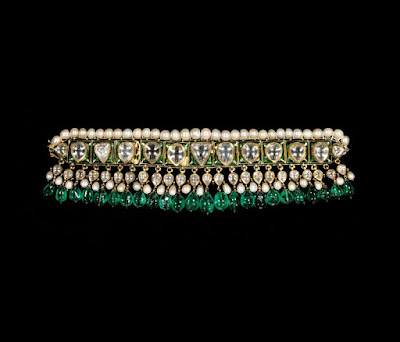The gypsies are a nomadic people that know no borders or countries. From their ancestry they were a people who were constantly on the move. But they originated in Northern India and hence even though centuries later they were found to be settled in larger numbers in Romania and other parts of Eastern Europe yet their language has traces of 'Punjabi' to this day; pointing to the original land of their forefathers.
Before becoming a Nomadic Diaspora these ancient people of the Punjab were slaves. And as was the cruel practice of Slavery they were kept shackled so as to prevent them from fleeing the person who owned them. Their shackles were thick pipe-like bands or manacles around their necks with long chains allowing individual movement; that went from one person to the other.
When these people, bonded by slavery, broke the manacles of cruelty by revolt and banded together as a clan they came to be known as Gypsy or Banjara.
They developed an identity of their own. They had their own dialect, laws, rules of engagement, ethics and of course a distinctive flair in clothing and especially jewellery.
It is human nature to rise from the ashes like a Phoenix and the gypsies too did just that!
They never wanted to forget their years in captivation so that History never repeats itself for their progeny, hence they developed a constant reminder of it in their jewellery repertoire.
This reminder was the ancient thick pipe-like banded manacle forcibly worn by their ancestors. They converted this manacle into a beautiful piece of jewellery worn both by men and women and called it the Hansli.
The Hansli was cast in silver for the Gypsies of Punjab. The men wore plain silver Hansli,but all kinds of innovated designs were etched on the precious metal to make it more attractive and decorative for the women.
Wherever the gypsy caravans moved, people were fascinated by this prominent neck-wear seen on the persona of gypsy women. As the women danced and sang on festive and marriage occasions for the wealthy, their jewellery, especially the Hansli shimmering boldly and strongly around their necks, while their colourful ghagras twirled around their pirouetting bodies had a mesmerising effect on the women who watched them.
Thus the Hansli was now incorporated into the jewellery cache of the women of Punjab.
It underwent a modification of sorts. It was now cast in pure gold with added adornments like tiny Pattis, ghungroos and gold beads dangling from the edge of the solid gold manacle.
The Hansli because of its solid form and its malleability and because of the softness of gold had no hook or tying threads at the back. Just a gap between the two ends of the ornament; that ended in a curved design.
How was it to be worn?
The woman just had to twist the Hansli wide open to insert her neck into it and then pull it back into shape!

After the Mughal Invasion of India the Hansli was included in the jewellery repertoire of the Invading Master by undergoing another change. It was now cast in precious gems like crimson rubies, sparkling diamonds, dazzling emeralds and royal turquoise all embedded in a manacle of gold which was now, because of the weight of the gems, not malleable. Hence the shape remained the same with a slight tweak to design. The gap at the back was widened to allow the neck to enter and from the two ends of the Hansli hung long gold and pearl strings to tie the ornament securely.
The Hansli of Indian Heritage, in the Modern World, has travelled the world to find itself displayed on Divas of the ramps of Haute Couture Presentations in Paris New York and Milan!








